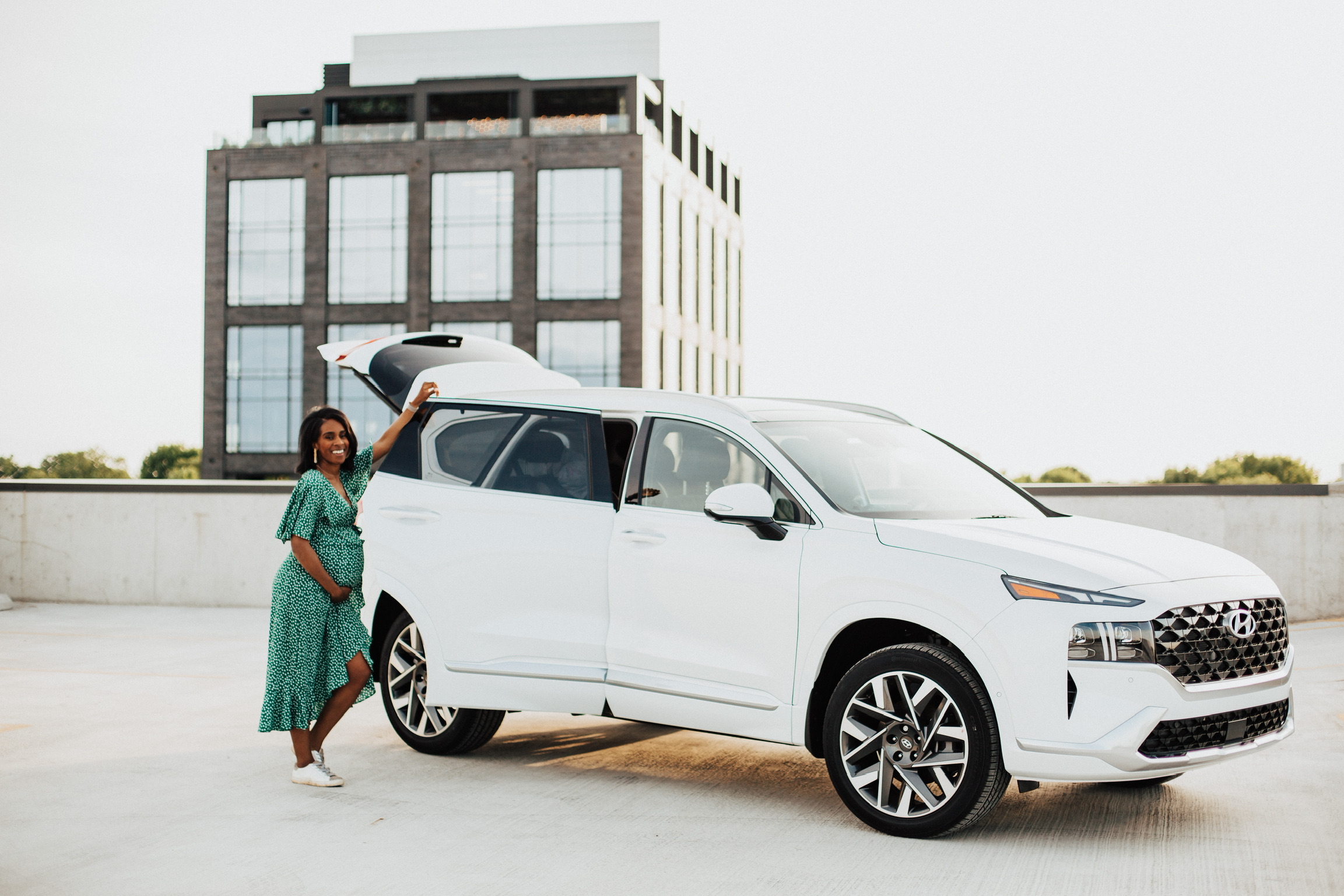Last weekend, we test drove an electric vehicle! For easy reference, I organized the blog into the below sections:
Electric Vehicle Facts (Financial Savings and Charging)
Our Experience
Pros/Cons
FAQs
Electric Vehicle Facts:
Electric vehicles are available in two types: fully electric and hybrid. Electric vehicles run completely on battery and require a charge from time to time. Hybrids, like the Toyota Prius, run on electricity for a certain speed/distance, then convert to gas mode. The gas powered engine then re-charges the electric battery automatically so there is no need for an external charge.




Cost Savings:
Since fully electric vehicles require no gas, you can expect your new electric bill to cost 1/5 less than what you pay for gas. For instance, if you spend $200-300/month for fuel, you would only spend roughly $25/month on electricity! What’s more, since an electric vehicle contains only a fraction of the structural pieces of a gas vehicle, you no longer have the oil change and maintenance costs associated with a gas vehicle. There is also an 8 yr. warranty on the battery and 50% of dealerships have electric car-savvy mechanics onsite to help with any issues.

Charging:
Charging sources are available in three forms: Level 1, 2 and 3
Level 1- Charger fits into a normal house outlet. In order to get a full charge from 0%, you should charge your electric vehicle between 18-24hrs. Charging cables are included with all electric vehicles.
Level 2– Charger looks like a washer machine outlet. This has an electrical charge (roughly 240 volts). Installation is required for these charging outlets; however, a lot of electric companies offer rebates that would cover the cost of installation. Level 2 charging stations are available all around the city. Often, there is reserved parking for your electric vehicle so no other vehicles park there.
Level 3- This charger takes between 45 minutes to an hour to charge from 0-100%. This type of charge is available in the bigger cities, but not as ubiquitous as level 2 chargers. You will know the difference between a Level 2 and Level 3 charging station because Level 3 typically costs more. The Plugshare app will also distinguish between level 2 and level 3 stations.




PlugShare app indicating a Level 3 stations in orange.
Our Experience:
Last Friday, we test drove the Nissan Leaf, a fully electric-powered car. We had the Leaf for the weekend, and left town. The Leaf’s full charge offered 135 mile range, which was perfect for our 122 mile trip! Before leaving Columbus, we were advised to download an app called “PlugShare,” that showed most most of the charging locations along our route. Additionally, we were also told to stop and charge our vehicle once 40 miles remained on the battery.

With a fully charged vehicle, we left Columbus for our destination. After 30 miles of driving on the highway, we noticed our electric vehicle losing energy quickly. City driving (braking and accelerating) feeds kinetic energy back into the electric battery helping the battery to retain a longer charger; however, on the highway (without much braking), there is no kinetic energy fed back into the battery. Basically, highway driving drained our battery faster than expected.
We planned to stop in a city close to our final destination and calculated enough energy to charge at our scheduled “midway” stop. On the way there, my husband asked me to check if the charging station would be open that late. I really never considered charging stations closing since I thought of them like gas stations.
Columbus provides ubiquitous electrical charging stations! However, the further from the main city, the less available charging stations AND some only open during business hours. Slowly, our calm, excited demeanor turned slightly stressed as we re-calculated our route.
We found a Level 2 charging station (roughly 8 hrs. to get from 0-100% charge). Our vehicle displayed 60 miles remaining and we charged for roughly 30-45 minutes, which gave us roughly 15-20 extra miles for a grand total of 75-80 miles. We only had 75 miles to our final destination so we thought we were good….boy, were we wrong.
Charging stations were not available until the next city (50 miles away). After 20 miles of driving, our battery showed only 40 miles remaining!! We were both frantic because we didn’t have enough charge to take us to our final destination and our battery was draining fast.
We started to brainstorm other options: “Uber/Lyft? Towing options? Who thought test driving was a great idea anyway?” The closest Uber/Lyft was 45 minutes away meaning waiting along the road side for an additional 20-30 minutes before pickup, plus trying to find a two. It was getting late, so we brainstormed other options.
We agreed to look for a hotel! At this point, only 10 miles remained until the battery would die. The nearest hotel was 8 miles away. Suddenly, the car’s interior dashboard lights started flashing, “WARNING, RECHARGE NOW. RECHARGE NOW” and the mileage disappeared. We pulled off the highway and arrived at the closest hotel just in time before the battery died for good.

While traveling out of town, we encountered some unexpected inconveniences: charging stations were spread out further than within the city. Typically only one charger station was available (versus many, many charger stations that a bigger city provides). There were charging fees at some stations, and maximum charging time limits (often 2 hours). The Leaf was much more efficient in the city: we drove roughly 10 “gas” miles and only exerted 2 “electric miles,” further demonstrating that electric vehicles are perfect candidates for city commuters.
When preparing our Columbus return, we charged our vehicle at a local dealer for free and left town around 2pm. On the highway, the battery again drained quickly. After traveling 70 miles, we only had 16 miles remaining until empty (135-70 does not equal 16). With our daughter sleeping in the back, we charged for an hour on a level 2.
After an hour of charging, we were only at 35 miles (from 16 to 35 in an hour). Long story short, we stopped two additional times to charge, but the combined charging time only cost us 45 minutes total (first stop: 30 minutes at a Level 2 charge; second stop: 10 minutes at a Level 3 charge). Our drive back to Columbus should have taken 2 hours, but it took 4 hrs instead.
PROS
Three types of charging options (Level 1, 2, 3- explained above)- Allowing convenience to charge at the speed you desire.
Great city miles!!- We rode 10 “gas” miles but only used 2 “electric” miles. In the city, using the brake more often pumps kinetic energy back into the battery resulting in longer battery life.
Lucrative tax credits and rebates– The Federal Government gives roughly $7500 tax credits to electric vehicle purchasers. Additionally, electric companies are offering significant rebates as a benefit to go electric.
Smooth and quiet ride– our daughter napped without a problem and the ride both in the city and on the highway was very easy.
Heats up quickly– The Weekend brought cold weather, but the car immediately heated up after starting. Much faster than our gas-powered vehicles.
Accelerates quickly– the Nissan Leaf sped up very quickly making for easy merging on the highway.
CONS
Fast battery drain on the highway– At one point during the trip, I visibly watched the mileage decrease within seconds.
Electric battery range is not often accurate on the highway– Since technology is still advancing, the remaining mileage is more estimated than exact (especially when the electric charge drops under 20 miles).
Long distance drives require lots of planning– In a gas powered vehicle, it’s easy to get up and go. In electric cars, you need to make sure the car is fully charged and map charging stations along your journey. Keep in mind some charging stations are only open during business hours, allow a maximum amount of charging time and have associated fees.
Charging availability– If outside a major city- charging stations aren’t always available. There was a lack of Level 3 (fast charging) stations away from the major city. Some stations charge/close early and you might have to wait on the charger if it’s in use by someone else.
FAQs (contains questions from my Instagram story).
How long does the car take to charge??
It depends on the type of charging plug. To fuel from 0% to 100%, here are the estimated timeframes to charge an electric vehicle:
Level 1- 24hrs
Level 2- 8-9hrs
Level 3- 45 minutes to 1 hour
How long does the charge last?
It depends on where you’re driving the vehicle. I shared in “Our Experience” (above) that a full battery charge lasted our vehicle 1.5hrs on the highway. However, I believe you could drive throughout the city for hours without charge since you’re recharging your battery with the kinetic energy produced by braking.
Do electric vans exist?
Absolutely!! Initially, I thought we were going to test drive an electric van instead of our Nissan Leaf.
What would you recommend for families/followers?
This is a great question! Electric vehicles are great options especially for people close to a major city. Bigger cities have more charging stations making electric vehicles more feasible (I’ve seen charging stations at grocery stores and banks in Columbus). If you’re a strictly city family, I would recommend looking into one. However, if you’re like my family (taking frequent road trips, visiting family 1+ hrs outside of your hometown, etc). I would recommend the hybrid type. A hybrid uses electrical energy and when depleted, converts to a gas powered vehicle. A hybrid allows for less stressful highway trips, minimizes tedious planning for charging station stops and cuts the amount of time on the road.
With that said, there areelectric vehicles with longer battery ranges that will limit the inconveniences that we experienced. For example, the newest Tesla models have 320 mile ranges (Nissan Leaf has a 130 mile range). Smart Columbus expects battery ranges to only increase as the technology advances. This will probably accompany more charging stations installed as more people adopt electric vehicles.
Would you have done it again?
Although the trip was stressful at times, we had a great adventure. Our test drive exposed us to technology of the future, but also provided the opportunity to get behind the wheel (literally!)
If we could repeat our experience, I would have requested a vehicle with a battery capacity greater than 135+ miles (probably 250+ miles). A larger battery would have eliminated the unnecessary stopping/charging and extension of our trip. Also, I would have requested more time to experience the benefits of city driving. I’m glad to gain knowledge/awareness, develop personal pros and cons, reflect on a funny text thread between myself, a member from the marketing department and a Smart Columbus representative documenting every step along the way!

What are yours thoughts surrounding making your next vehicle an electric one? For more information, visit: Smart Columbus Drive Electric
Thank you Smart Columbus for sponsoring this post!









Omg that sounds so stressful. I almost bought a leaf while waiting for my Tesla. Sounds like it’s a better car for city than highway.
I would say that anything had a larger battery would be better especially if you’re traveling on the highway a lot. Did you end up getting your Tesla?
Interesting article. We just took our Leaf to Cleveland and didn’t have nearly as stressful of a trip (but we do have 2 years of EV driving experience so that definitely helps). There is definitely a certain level of planning that has to go into an EV roadtrip. The is an E plus version of the Leaf available now with a 60kwh battery (over 220 miles of range), which would likely have lead to a much less stress inducing test drive.
There are actually 3 different kinds of these types of vehicles. EVs are as you described a vehicle powered entirely on electric. Hybrids match your description as well being an all gas vehicle that has a battery which captures power from braking. But there are also PHEVs which are a EV plugin hybrid. They have both a gas engine and a electric motor that charges when plugged in. These are great for people who want to use electric for commuting as they often get 25 miles (or more) on a charge but have the gas option for longer trips or times when a charger isn’t available. It kind of gives folks the chance to try EV without the full commitment if they aren’t ready to make the jump.
I believe if we had a vehicle with a larger battery, we wouldn’t have encountered the issues that we did. You’re correct, there is definitely a level of planning involved and that’s something to consider. Overall, we really liked our experience!